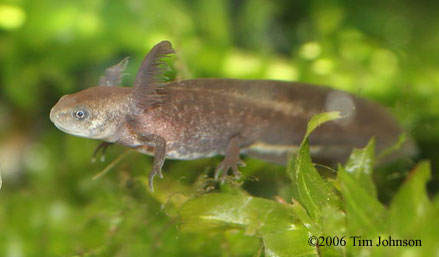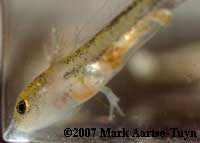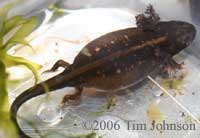Why Larvae Die

By Jennifer Macke
Raising salamander larvae isn't easy. Even the most experienced breeders have losses. Many hobbyists have watched in distress as an entire brood of larvae dies. Why? This article attempts to give a comprehensive list of the possible reasons.
Bear in mind that death of any amphibian is often multi-factorial, the result of several problems acting together, rather than a single problem. In particular, stress-related factors are usually contributors, not the sole reason for death. Some species are affected by particular factors, while others aren't. Very few things are universally true for every species or every situation.
Some of the factors listed here are speculative and/or anecdotal. Although I've attempted to draw on the experiences of many breeders, everyone has their own interpretations about what may have caused a particular group of larvae to die.
Reasons for Eggs and Larvae to Die
Environmental Problems
Water source - In most cases, dechlorinated tap water is perfectly fine for raising larvae. However, there is no simple answer to what is the "best" water to use. Pure distilled or RO water is not recommended. Rain water may be OK for some species, but not for those adapted to hard water (see below). As long as the water has no chlorine and a reasonable pH (6-8), it should be OK.
Water quality – Build up of ammonia or nitrite in the water is toxic. This can happen if the animals are crowded, uneaten food is left in the tank, or water changes are insufficient. Larvae generally need larger and more frequent water changes, as compared to maintenance of adult animals. Larvae can easily tolerate a change of 100% of their water, provided that this is done frequently (every few days). After a few days, water chemistry begins to shift, so the more days between changes, the more stressful a large water change will be. While a large tank of adult amphibians is "forgiving" if you miss an occasional water change, larvae are much more sensitive.
General cleanliness – If the larvae are kept in "simple" setups, clean-up of uneaten food and waste is usually essential on a daily basis (yes, daily!). If food is sticking to the inside of the container, it may also be necessary to transfer the larvae to a clean container. If a lot of larvae die for unknown reasons, one first step to take is to transfer the survivors to a fresh container of fresh water.
Biological components – This idea is largely speculative. The slime that forms on the surfaces in a cycled tank is generally considered good, as it contains beneficial bacteria. However, the slime that forms in only a few days inside a fresh container may be unhealthy, particularly if bits of uneaten food stick to the inside of the container. In this case, wiping the inside of the container (or transfer of larvae to a clean container) will prevent the growth of mold and non-beneficial bacteria on this surface.
Temperature – Larvae are more sensitive to improper temperature than adults. Both too-high and too-low temperatures can be harmful, depending on the species.
Water hardness and pH – Unfortunately, little is known about the water hardness and pH tolerances of most caudates. Most species are fairly tolerant, but for some species (and for some water sources) these factors could be an issue. Consider the hardness of your water source and how it compares with the natural water source typical for the species you are raising.
Lack of aeration – Larvae kept in a deep container without live plants and without an airstone may have insufficient oxygen in the water. This is more likely to be problem if the temperature is also on the too-warm side.
Substrate – For most larvae, the use of substrate (e.g., sand, gravel) should be avoided. Having a container with a bare bottom makes cleaning much easier; sand and gravel tend to accumulate filth. However, there are circumstances where having substrate may be desirable. If the larvae are being raised in the same tank with the adults, then the existing substrate should be left in place. A study done on a stream-dwelling species (Euproctus asper) found that larvae did better with a gravel substrate, possibly because the larvae were better able to keep their gills exposed to water (Wisniewski, Patrick J. 1986. Substrate and tadpole survival in Euproctus a. asper. British Herpetological Society Bulletin. (18):19). In my own experience, I find that larvae of Neurergus strauchii do better when kept without plants, but with large pebbles on one side of the tank. Both of these species (E. asper and N. strauchii) are stream-dwellers and thus have environmental needs that are different from most species raised by hobbyists.
Food Problems
Lack of live food – While there have been cases of caudate larvae being raised entirely on pellet mash or other non-live food, success is rare. For most people, best results are obtained with live food, at least for the first few weeks.
Lack of preferred food – Some species will do better with a particular food. For example, some prefer food that swims mid-water, while others prefer food that stays on the bottom. Also, when transitioning a group of larvae from one food to another, some animals may lag in growth if they do not adapt to the new food. Any individuals that lag in size are at greater risk of death from a variety of causes.
Insufficient feeding – Unlike adults, larvae cannot live for days between feedings. Depending on the temperature, they generally need to be fed at least once a day, or have live food available most of the time.
Leftover food – This is the biggest contributor to poor water quality (see Environmental Problems). The breeder must strike a careful balance between supplying sufficient food and the absence of decaying leftovers.
Inborn Defects
Small, slow-growing larvae – Some species are more challenging to raise because the larvae hatch at a very small size, or grow slowly. While this may be completely normal for the species, it makes the job harder for the person raising them and increases the chances that other factors will take their toll.
Random genetic/developmental problems – It is common for a small percentage of larvae to simply die or suffer obvious defects. These individuals could be mutants, or could be the result of a poorly-produced egg. If more than 5% of the offspring die, this is not the cause.
Maternal nutrition – If the female was undernourished or fed a nutritionally-poor diet prior to laying eggs, the resulting larvae may be weak. Maternal diet for the entire year prior to breeding is probably important.
Maternal age – In some species, the first few batches of eggs produced by a young female are inferior. The eggs may be smaller than normal, and the eggs and early larvae may be difficult to raise and experience high mortality.
Inbreeding – This factor is often debated. While common sense suggests that inbred offspring will be weaker, experience indicates that inbred offspring are often very healthy.
Developmental arrest in Triturus – There is an unavoidable genetic defect that causes 50% of all eggs from the following species to die: Triturus marmoratus, Triturus pygmaeus, Triturus cristatus, Triturus karelinii, Triturus carnifex, and Triturus dobrogicus. This defect only affects the eggs in early development; those that hatch should develop normally. This defect applies only to these 6 species.
Disease – Disease is rarely the primary cause of larval death. Disease should be considered as a cause only after all environmental and feeding factors are ruled out.
Fungus - Even if your animals are covered with fungus (white fuzz) at death, this does not mean that the fungus killed them; the fungus may simply have covered them after death. It is possible, however, that fungal infection could be a contributing factor in death. Also, some batches of eggs have been known to fall victim to fungus before hatching. Infertile eggs will always become moldy, but if the eggs are clearly developing into embryos before becoming moldy, this can be treated (see Treatments).
Bacteria – Based on my own experience, I would say that bacterial infections are rare, but I did experience one clear-cut case of bacterial infection in larvae. See Case History below.
Parasites – I don't know of any confirmed cases of parasites, either external or internal, infecting larvae. Internal parasites are not expected in captive-bred caudates. However, when raising wild-caught larvae, it is possible. Also, parasites can be acquired in captivity, either from live food or from other animals.
Stress
Crowding – Crowding causes stress in several ways. It can contribute to underfeeding, poor water quality, and cannibalism. Also, larvae may be stressed simply by being in close proximity to many others. Caudates are carnivores, so every sibling is a potential threat.
Cannibalism – Some species are prone to cannibalism, particularly at certain stages of development. Large size differences among the larvae will increase the chance of cannibalism. Crowding or underfeeding will also increase the chance of cannibalism.
Lack of hiding places – I have found that larvae raised in small containers without plants or other hiding places act more stressed (demonstrated by frantic swimming when disturbed) and grow less well.
Bright lights – This is speculative, but in the wild, caudate larvae are rarely exposed to bright light. Thus, bright light could contribute to stress.
Size differences – Small larvae may be stressed by the presence of larger siblings.

Common symptoms of sick larvae
Internal air bubbles – Most often caused by underfeeding (or undereating), which causes the larva to gulp air. Can also be caused by not allowing degassing (aging) of fresh water before it is used for water changes. If the bubbles are in the digestive tract, the larva will often expel the air and recover. Move the affected larva to very shallow water with lots of aquatic plants so that it can rest comfortably. Provide live food if possible.
Floating – Sometimes larvae will float, even in the absence of visible internal bubbles. This is probably a symptom of stress, or possibly underfeeding. Move the affected larva to very shallow water with aquatic plants so that it can rest comfortably.
Fluid bloat – This is the result of a problem in fluid balance, typically caused by a metabolic dysfunction. It can be a symptom of water quality problems. If only one larva is affected, it is more likely to be a random genetic defect affecting fluid balance or organ development. There is no treatment, other than euthanasia or "wait and see". In rare cases, the larva may go back to normal.

Curled tail – This is a general symptom seen near death. It has been seen in larvae stressed by a number of factors, including bacterial infection.
Missing body parts (legs or pieces of the tail) – This is a clear sign of cannibalism. Reduce crowding and increase hiding places. Increase feeding, but with care not to allow leftover food to degrade water quality.
Total disintegration - If the bodies of the larvae completely disintegrate when they die, this is suggestive of a bacterial infection. This can also be due to warm temperatures and may or may not indicate other problems.
Fungus – If the larvae start to get fuzzy BEFORE they die, consider the possibility of fungal attack. However, fungus rarely attack larvae unless they are under stress from other causes.
Spinners – This is caused by an occasional genetic defect. Some spinners turn in circles, while others swim in corkscrew fashion. It is possible in some cases to raise a spinner to adulthood, but they are likely to eat poorly, and likely to drown at metamorphosis, so it is probably better to euthanize them.
Death at metamorphosis – This is probably the most frustrating problem of all. The cause is unknown, but sometimes an entire batch of offspring will all die at metamorphosis. Metamorphosis is, itself, stressful and thus other latent factors that didn't affect the larvae may become deadly at this time. In some cases this may be a latent infection with a virus or chytrid fungus - a necropsy is required to determine the exact cause.
Treatments
In my experience, disease is a rare problem. Other causes should first be ruled out before attempting treatment. The following are things that have been used to treat problems with amphibian larvae.
Immediate measures:
- Change of container and fresh water
- Change of water source
- Change of type of food
- Separation of larvae into multiple containers
Medications used successfully (anecdotally) on caudate larvae:
- Salt bath – has been used to treat fungus problems on eggs. See salt treatment article.
- Methylene Blue – used to treat fungus on eggs and larvae
- Antibiotics, such as kanamycin, nitrofurazone, furazolidone, etc. See caudate illness article.
Case History
I've had one "diagnosable" problem while raising Triturus karelinii larvae. I was raising them in 3 separate tubs. The larvae started dieing in one tub. In a few days, I lost 11 out of 12, with the last one saved by moving it into a clean container every day. A few days later, the same thing started in the biggest tub, which had 30+ larvae in it. I lost one, then two more, then I lost about 12 of them the next night (an exponential death rate). The third tub containing another 10 of them remained 100% alive. I knew this wasn't a water quality problem, as I monitored the water carefully in all 3 tubs, and followed the same procedures for all of them. The larvae in the 3 tubs were all getting the same food. I reasoned that it had to be something contagious, and I knew that the way it was going, I could lose them all. I put in a broad-spectrum antibiotic (kanamycin + nitrofurazone) in the remaining 2 tubs, and the deaths immediately stopped. Other than "death", the only symptoms observed were: some had a curled tail before they died, and the dead bodies disintegrated rapidly into just a tiny ball of fuzz.
Note that this incident has several features that strongly indicate that the deaths were caused by infectious disease: (1) near 100% mortality (2) one container affected, while another was unaffected, (3) exponential death rate, and (4) immediate cessation of deaths after treatment. No cultures were taken, and the antibiotics used were broad-spectrum, so there is no way to know what type(s) of bacteria were responsible for the problem. Subsequent to this incident, I have raised several batches of the same newt species with no treatment and near-zero mortality.
Other Resources
- Caudate Illness Part 1: Symptoms and Treatments
- Caudate Illness Part 2: Treatment Accounts
- Caudate Illness Part 3: Illness Photographs
- Treatment of infected wounds
- Salt solutions for treating amphibian illness
- Bloat in newts
- Axolotl.org Health page - Includes a list of safe and unsafe medications for salamanders.
© Jennifer Macke, 2005. Revised May 2008.
